
Outdoor cooking over a grill is probably America’s most beloved summer pastime. Whether you prefer burgers and hot dogs, chicken, pork, seafood, or vegetables, this highly versatile cooking method makes everything taste better — and it’s always more fun to cook on the deck or patio.
With so many grilling options — you’ll find dozens of charcoal, wood, gas, and pellet grills available, we decided to go head to head to make your decision a little easier. We cooked a whole range of dishes over charcoal, pellets and gas and figured out the advantages and disadvantages of each approach to help you understand the differences and chose the best one for your lifestyle and your budget.
A great propane grill
The three-burner Weber Genesis E-325s offers the clean results of the best gas grills, along with an extra-hot searing burner for the char effects that can be hard to achieve otherwise.
A versatile pellet grill for precision cooking
From the company that developed the pellet grill, the Traeger Ironwood 885 can manage temperature precisely, letting detail-oriented cooks do everything from perfectionist convection cooking to smoking, with precision control via a connected app.
A great kamado-style ceramic grill
Big Green Egg popularized the kamado-style grill in the United States, and it’s easy to see why. Versatile enough for smoking, grilling, pizza baking and as an outdoor oven, the Egg’s ability to hold heat makes it a great tool for the cook who likes to change it up.
An affordable way to get into Argentine-style grilling
We tested the larger Nuke Delta grill, but for those looking to experiment with Argentine hearth-style grilling techniques, the smaller Pampa is a more budget-friendly tool, and still gives you plenty of space to feed big groups.
A stylish, powerful and highly portable grill
The YAK grill is small enough to use almost anywhere, and can even be used on a tabletop. Plus the well-designed stainless steel device is not just easy to use, but simple to clean.

According to archeological evidence, humans have been grilling — quickly cooking food over a direct flame or radiant heat — for at least two million years, and it remains one of the most popular methods of cooking.
Grilling is special because it jumpstarts the complex chemistry that gives meats a delicious crust, flavor and texture profile. The intense heat of the grill triggers the Maillard reaction (in which the compounds in food — the proteins, amino acids and sugars in meat, for example — react to create darker colors and more intense aromas and flavors) along with caramelization (where at even higher temperatures the sugars in the meat and rub or marinade brown), and char (in which the burning fuel and the vaporized drippings from whatever you’re cooking impart even more flavor to the meat).
While many people refer to all grills as barbecues, grilling and barbecuing are not the same. Barbecue is a specific style of cooking meat at low heat (under 225 degrees Fahrenheit) over long periods (usually measured in hours), and generally uses wood fuel (typically hardwoods and fruitwoods) to provide indirect heat and the smoke that gives barbecued food its characteristic flavor.
When shopping for a grill, your first decision is the fuel type. Gas, charcoal, pellet and wood grills not only perform differently and let you use different cooking techniques to achieve different flavors, but they vary in start-up time, convenience, and ease of cleanup. To add functionality and to make it easier to take care of your grill, you’ll also want to invest in a few grilling accessories. Adding tools like a dependable meat thermometer and a durable grill brush to your arsenal will make the job a lot easier.
While certain types of outdoor grills (such as kamado-style, kettle-style, or pellet-fed) may also be used to smoke meats at lower temperatures with longer cooking times, dedicated BBQ smokers like an offset smoker, a “bullet” or vertical smoker, or an electric smoker that burns wood chips or pellets, are generally designed specifically for that one purpose.
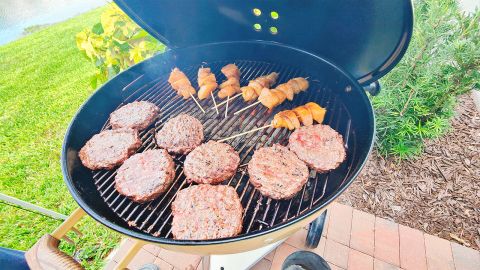
The latest refinement of a 70-year-old design, the Weber Original Premium Kettle Grill represents the type of charcoal grill most people are familiar with. A kettle grill is simple to use, effective, and affordable. But most importantly, the results are fantastic. With a little effort and experience, a simple kettle can turn out fantastic grilled meats and vegetables, letting you take full advantage of the high heat of charcoal grilling in a very accessible format.
The design — a roughly bowl-shaped basin on tripod legs covered by a lid — is space- and fuel-efficient, and temperature management is straightforward using vents at top and bottom along with judicious opening and closing of the lid.
Kettles like the Weber can grill at high temperatures (over 700 degrees F), and with some skill can be used for low-temperature tasks including BBQ or smoking — which makes them incredibly versatile. Maintenance is simple too, with most offering a removable ash hopper at the bottom of the bowl.
If it’s flavor you’re after, the charcoal grills gave us the best results of any grilling method we tested. Because charcoal grills get hotter than any other type of grill, the larger surface area means you get all-over radiant heat you won’t get from gas, and the coals themselves lend food the distinctive taste that most of us associate with grilling in the first place.
The burgers we cooked on the charcoal grills were juicier and better tasting than the gas grill or even the pellet grill, offering a delicious crust and that distinctive “char” flavor which you’ll also get when cooking steaks, pork, chicken, seafood, or vegetables.
Cooking over charcoal is simple and can give you a sense of tangible enjoyment no other method can match. And as long as you can pay attention to fire management, you can get a low-temperature burn, perfect for cooking low and slow for smoky flavors.
Whatever type of charcoal grill you choose, they all work on the same basic principle: you get a pile of charcoal fuel burning (for ignition, we highly recommend skipping the old-school lighter fluid and using a chimney starter, a propane torch, or an electric heat gun like the Looft Lighter), spread it out in a basin, and once it’s white-hot and burning continuously, cooking grates are installed above that and the food placed either directly above hot fuel for direct heat cooking or further away from it for indirect heat.
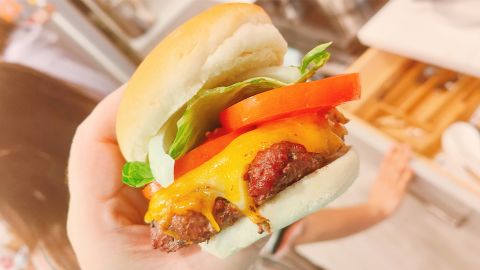
Charcoal generates super high temperatures and can burn for hours. It can be stored safely,, is relatively affordable, and since the grills typically don’t have any mechanical parts aside from whatever device is used to empty the ash hopper, charcoal grills typically require very little long-term maintenance aside from inexpensive part replacement.
We found two big downsides to grilling with charcoal: time management and temperature management.
First, it takes much longer to get the grill fired up and hot enough for cooking than with any other method – a good 15 to 30 minutes, depending on the grill size. This means you can’t just decide to throw some burgers on — you’ll have to think ahead. The ignition process also takes a little work, as well as an extra tool such as a torch or chimney. And it’s much harder (though not impossible) to get a charcoal grill started in windy or rainy weather.
Second, managing the temperature of a charcoal grill takes some work. Once you’ve got everything going, it isn’t a set-and-forget process as with a modern kitchen stove. You’ll need to interact with the pile of hot coals and get used to manual venting to maintain temperature and get the results you want — it can be a wonderfully tactile experience, but is more labor intensive than other grilling methods.
Lastly, charcoal grilling produces a lot of ash, so it involves more cleanup than other methods. And because you can’t start tidying up until the grill cools off, there’s even more waiting before you can dispose of the ash left in the hopper.
Beyond the popular kettle grill, you’ll find many types of charcoal grills, so we tested several of the most popular variants. The basic principles are similar, but their varied construction methods and layouts give them a range of abilities that suit different types of cooking
We tested four charcoal grills — along with the Weber kettle-style charcoal grill, we looked at the Big Green Egg kamado-style ceramic grill, the Nuke Delta Argentinian grill, and a YAK shichirin or “hibachi” grill.

A kamado or “egg” style grill is similar in appearance to a kettle grill, except that it is usually made of thick ceramic material. The cooking style traces its lineage back to clay-pot cooking techniques used in China and India (the word “kamado” originates from a Japanese adaptation of the same method). Modern kamado-style grills are available from many companies, though the most well known is Big Green Egg, who popularized the concept in the US in the 1970s.
Because their ceramic casings are so heavily insulated, kamado-style grills can capture and hold a lot of radiant heat — making them great not just for grilling, but for low temperature cooking tasks such as barbecuing and smoking or brick-oven style pizza and bread baking at temperatures up to 700 Fahrenheit. Fueled with lump hardwood charcoal, larger kamado-style grills include multiple racks that can be stacked vertically for baking or to let them double as a vertical smoker, giving them a considerable capacity in a relatively small space.

Known popularly in the US as a hibachi (a term which in Japanese actually refers to a small stove used for heating; small cooking stoves are referred to as shichirin), this style of charcoal grill is very simple — a small metal box topped by a metal grate, suitable for use almost anywhere, and perfect for travel, camping, tabletop use and so forth. Like most charcoal grills, they can use briquettes or lump hardwood charcoal, and are very versatile.
There are dozens of variations on the design, ranging from the stainless-steel YAK grill we tested to disposable, single-use charcoal hibachis meant for camping trips, tailgating or bringing to the beach.
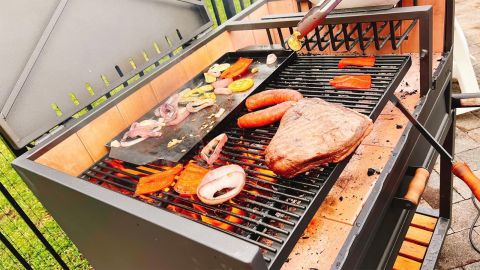
Sold under many names, this style of rectangular grill has its origins in the style of cooking known in South America as asado, done on a simple grill known as a parrilla — basically a portable hearth. To use it, you ignite your coals (lump hardwood charcoal is suggested) in a firebox or brasero, which sits next to the grilling area, then once they’re white hot you dump them onto and spread them out on the main surface, above which a grill grate is suspended; to control the temperature you raise or lower the grate or change its angle.
Cooking on a parilla is a slow process with a learning curve, but it’s great for large proteins or just preparing food for large parties. Modern versions of these grills are often made out of heavy-duty carbon steel, and are not designed for portability or even to be moved around your backyard easily — the Nuke Delta we tested weights 284 lbs, but that supports a massive 40-inch wide cooking grate with some 547 square inches of cooking space on it, so it has a huge food capacity.

If you want to grill but you don’t want to wait, a gas grill is the ultimate in outdoor cooking convenience. There’s no fussing with fire starters or babysitting hot coals; just open the valves controlling the burners, hit the ignition button and within 10 minutes, the grill will be above 600 degrees and ready to go. You can have dinner ready any night of the year within 30 minutes; bad weather be damned
Gas grills are also much simpler to manage than charcoal. Cooking on a gas grill is nearly as easy as cooking on the stovetop. Gas burners give you precise temperature control, from around 300 on up to 700 degrees Fahrenheit, and individual control of multiple burners lets you adjust for small or large meals, or create cooler and hotter zones for indirect cooking and convection effects. You can, for instance, run with a single burner if you need to cook just a couple of burgers or chicken breasts for dinner, or if you want to cook a protein longer with indirect heat.
So long as you set up everything correctly (and have an instant-read meat thermometer to check your proteins for doneness), you can come out looking like a grilling superhero every single time.
With gas, we got solid Maillard reactions when cooking meats such as burgers and steaks – nice crusts, but with a cleaner flavor because that “char” was not present. We found ourselves using more marinades, sauces, and seasonings with gas-grilled foods than charcoal-grilled proteins and vegetables, and the food tasted lighter. We do not view this as a negative simply because gas grilling tends to lend itself well to healthier cooking overall.
Propane and natural gas (gas grills can run on either, with the appropriate fittings) are clean-burning and generate excellent levels of searing heat; not quite as hot as charcoal, but hot enough for good results from most anything you’d want to grill.
While cooking with gas has a lot of advantages, making it a great choice for many, the technique has some downsides.The first being that it just doesn’t taste like charcoal; because the clean burning fuel doesn’t impart any intrinsic flavors, you get neutral and natural-tasting grilled food rather than a smokey or char-broiled flavor. You can enhance the flavor or even get smoker-like effects at low temperatures by using foil packets of wood chips or wood pellets placed above the burners’ heat deflectors, but the results are different than cooking over charcoal.
Since the burners are a smaller, cooler heat source than a pile of burning coals, less of the cooking in a gas grill happens by radiant heat. This means that more heat is distributed to your food via the grill itself, so you get distinct lines on your chicken breasts with relatively paler meat in between rather than the all-over crispiness you get from charcoal.
Finally, while there is no ash buildup and gas grills are easier to care for on a daily basis than their charcoal-burning cousins, gas grills require a little more long-term care and maintenance. You will have to periodically clean up grease and particle accumulation on the deflectors, burners, air shutter screens, the catch pan, the grease tray, and the firebox itself.
Gas regulators, which control the amount of gas pressure going into the grill, have a lifespan of 5 to 10 years (these cost around $50; plus you may occasionally have to purge them if they are clogged by “vapor lock”). Electric igniter batteries need periodic replacement as well, and the gas burners themselves also eventually may eventually require replacement as they wear and can eventually crack (a set of three tubes usually goes for about $50).
Additionally, you’ll want to buy a cover for your gas grill to keep it out of the elements, as weather can cause the mechanical parts to deteriorate. And if you’re using propane cylinders, keep them outside, in a cool, shady place. (Never store them in your home or an enclosed area such as a garage, shed, or basement, and keep them away from flames, sparks and temperatures above 120 degrees Fahrenheit).
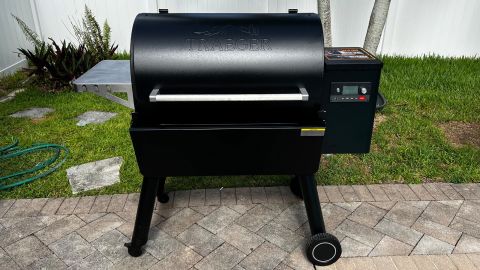
Pellet grills are ideal for anyone who wants slow-cooked, woody barbecue flavor without the fuss of charcoal. They are also perfect for aspiring grillmasters who love nerdy, high precision cooking. Pellet grills function much like pellet stoves: an electrical ignition system fires up a fuel supply of hardwood pellets, then a series of fans (much as in a convection oven) let you manage temperature very precisely using either onboard electronic controls or a connected app.
Pellet grills can’t get as hot as charcoal or gas grills, but they can maintain stable low temperatures (under 225 degrees Fahrenheit) for barbequing or to double as smokers, and can also sear quite nicely at their limit of around 500-degree Fahrenheit.
Burgers, chicken thighs, and sausages pleased the crowd we fed using the Traeger 885 we tested, and there was not a single complaint about anything being over- or underdone. We cooked many items on the pellet grill, including pork shoulders, chicken thighs, moinkballs (bacon-wrapped meatballs), shrimp, stuffed jalapeno poppers, pastrami-wrapped hot dogs, and all kinds of vegetables.
Everything came out perfectly cooked and juicy, but we were particularly impressed with the shrimp — a protein that is easy to overcook. We were able to do this because the Traeger, like many pellet grills, features computer control over temperature, letting us cook the shrimp at a stable 225 degrees. It’s a perfect setup for cooking tasks that require low temperatures and long cook times.
While pellet grills give you some of the flavor of charcoal grilling, they can’t hit the same high temperatures — so while you get the woody, smoky flavor, you won’t get that quick sear and distinctive grilled taste. While pellet grills do burn wood fuel, they are fundamentally electric appliances. And though you’ll get the precision control they are noted for, there can also be some discrepancies in performance.
During the times we ran it at maximum temperature with steaks and burgers, the Traeger 885 gave us more of a perfectly even convection oven-cooked effect rather than the kind of direct heat sear you would find with a charcoal or a gas grill — with a hint of smoked fruitwood flavor rather than a charbroiled flavor. And though we didn’t see the “crust” on meats that you would see with a charcoal or gas grill, the computer temperature control ensured that we never overcooked anything. If you’re a purist, however, this may not satisfy you in the same way.
Since pellet grills are electric, you’ll need a weatherproof electrical outlet wherever you want to grill (or you’ll need a generator or power station with an inverter to supply power). Pellet grills are also much more mechanically complicated than either a charcoal grill or a gas grill, because of the feed motor for the hopper/auger, the heating element, electronic thermostats, fans, and the computer control system.
Pellet grills do require periodic cleaning to prevent malfunction, which requires replacing the grease trap, emptying out the pellet hopper and removing residual sawdust, removing and cleaning grill grates, removing and cleaning the drip tray, removing and cleaning the heat deflector, and cleaning out the entire interior of the grill including all of the ash accumulation below the firepot.
We cannot stress enough that because this is an electrical appliance, you want to have a weatherproof cover on the grill when it’s not in use. Ideally, it should also be kept in a shed, covered patio, or a balcony to keep it away from the elements. Additionally, pellets should not be stored in a hopper for longer than a week because if they absorb too much moisture, they begin to crumble and become soft, which causes issues with temperature consistency and can cause clogs in the auger or firebox.
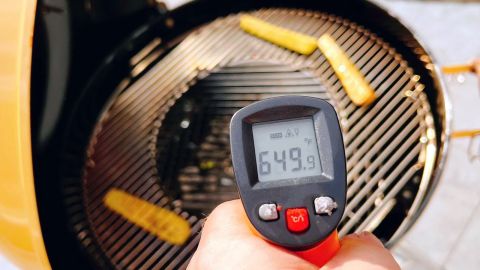
To assess the relative strengths and weaknesses of each cooking method, over eight weeks, we dedicated the entire patio of our home to testing six grills — a Weber kettle-style charcoal grill, a Big Green Egg kamado grill, a Nuke Delta Argentinian grill, a YAK hibachi/shcihirin grill, a Weber Genesis gas grill, and a Traeger Ironwood 885 pellet grill.
Multiple flavors of Traeger-brand pellets were used as fuel for the Ironwood 885. Propane was purchased for use with the Weber Genesis. For the Weber Kettle, we used Kingsford Original briquettes as fuel. For the other charcoal grills, we used Brazilian eucalyptus blend and Argentine quebracho lump charcoal purchased from local supermarkets in south Florida.
Various proteins were cooked on each grill, including hand-formed burgers (typically 80 percent lean ground beef), New York strip steaks, Brazilian Tri-Tip, Filet Mignon, Chicken Thighs, Pork Sausages, Hot Dogs, Bacon, and Shrimp. Various types of vegetables were also cooked, including onions, peppers, eggplants, tomatoes, and corn. Proteins were seasoned with a variety of rubs from different manufacturers including Traeger and Weber. BBQ sauces from these companies were used as glazes during the final minutes of cooking at high heat.
Each grill was fired using manufacturer instructions, and cooking was done after the recommended preheating period. Charcoal lighting on the kettle was done using Kingsford and Weber chimney starters with crumpled newspaper as kindling, and the Looft Lighter Classic was used for the lump charcoal grills.
For instant temperature readings on grill heat, we used an infrared thermometer, and we used a Thermapen MK4 for determining meat doneness.

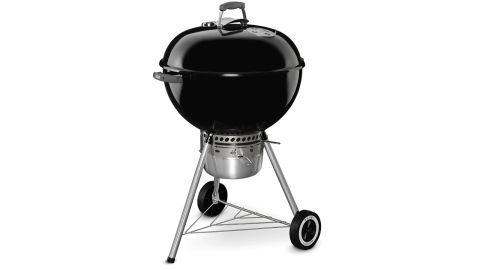
التعليقات